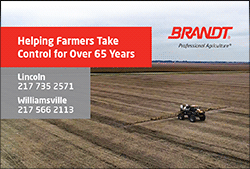|
University of Illinois Extension conducting impact study on 2019
delayed planting season
Local producers urged to participate
regardless of when they got their seed in the ground
 Send a link to a friend
Send a link to a friend
[November 19, 2019]
Project
Background - When 2019 corn and soybean
planting in Illinois stretched into June, and even July in in some
locations, the commercial agriculture community found ourselves in
unchartered territory. We spent considerable time grasping for any
information we could find on the potential impact this would have on
yield and trying to understand what management changes we should
expect because of the drastically delayed planting. While the
planting date data we could find was somewhat helpful, we did not
have any data that provided insights based on a planting season that
was delayed into late June.
|
|
 While it may be tempting to write off this year as a fluke from
which there are no real lessons to be learned, we may want to
rethink that. What we have is a giant, unplanned, and
involuntary experiment that is being conducted by Illinois
farmers this year that can help us understand the ramifications
of how planting date and variety maturity affect overall yields.
We have an opportunity to collect a small amount of data on a
large number of fields, which can provide some idea of what we
can do if we find ourselves in this kind of situation again in
the future. While it may be tempting to write off this year as a fluke from
which there are no real lessons to be learned, we may want to
rethink that. What we have is a giant, unplanned, and
involuntary experiment that is being conducted by Illinois
farmers this year that can help us understand the ramifications
of how planting date and variety maturity affect overall yields.
We have an opportunity to collect a small amount of data on a
large number of fields, which can provide some idea of what we
can do if we find ourselves in this kind of situation again in
the future.

How You Can Help
To do this, we have a simple request: Please share your
information with us. We are attempting to gather the following
information from as many fields as possible.
-
Illinois county where the field is located
-
Crop: corn or soybean
-
Planting date
-
Maturity rating (corn relative maturity (days RM); soybean
maturity group)
-
Yield
-
Harvest moisture
-
Information on weather or management can be added, but this
is optional.
-
Submit Your Information
The information can be submitted in one of two ways:
-
Print the 2019 Crop Planting Date-Yield
Survey:
https://ewm. extension.illinois.edu/sites/
default/files/2019_yield_survey_ table_new.pdf
Fill it out for as many fields as possible. Send a copy via
email to Chelsea Harbach (harbach2@illinois.edu).
[to top of second column] |

-
Complete an online form:
https:// illinoisaces.co1.qualtrics.com/jfe/
form /SV_3k4Xl3RH8pE84K1 to report your data one field
at a time. You can submit this form for multiple fields by
following the link as many times as you need.
Our goal is to collect all of the data by December 31, 2019.
A Few Notes About Submitted Data
We are looking for data across a wide range of planting dates and
not just from fields that were planted late. Did you get some fields
planted in April prior to all the rain? That information will be
just as valuable as the details on fields that were not planted
until mid-June.
If you have yields from strip trials with different hybrids or
varieties with different maturities, we can use that but please
specify that they are all from the same planting and field.
If a field has spots that were drowned out and thus have no yield,
either do not use the data OR estimate the yield from the yield
monitor based on parts of the field that had good stands.
Alternatively, you may estimate the percentage of the field that
does not have stand/yield and we can use that to estimate the yield.

We appreciate your participation in this study. The data we receive
will help us learn more about the impact of drastically delayed
planning on yield and potentially better manage these situations in
the future.
[Chelsea Harbach, Commercial
Agriculture Educator, University of Illinois] |